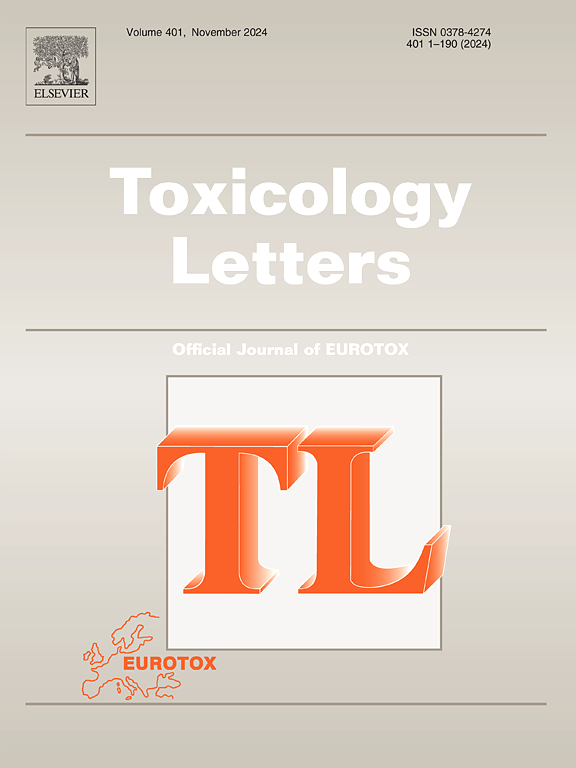Copper exposure at a daily dose twice the recommended in diabetic rats induces oxidative stress, vascular dysfunction and perivascular adipose tissue inflammation in diabetic rats
IF 2.9
3区 医学
Q2 TOXICOLOGY
引用次数: 0
Abstract
Individuals with diabetes often have a heightened risk of cardiovascular diseases and present copper (Cu) metabolism imbalances. We investigated the effect of chronic exposure to twice the recommended daily dose of CuCl2 on vascular reactivity in isolated thoracic aorta segments of diabetic and non-diabetic rats. Eighty male Wistar rats, aged 12 weeks, were divided into four groups: Control (Ct), Copper (Cu), Diabetes Mellitus (DM), and Diabetes + Copper (DM+Cu). Type 1 diabetes was induced using a single dose of streptozotocin (65 mg/kg i.p), and the animals exposed to Cu received twice the recommended daily dose (25.7 µg/Kg/day CuCl2) for 30 days. After treatment, we investigated vascular reactivity and performed histological evaluations on samples of aortas and perivascular adipose tissue (PVAT). Our findings revealed pronounced weight loss and higher hyperglycemia in the DM+Cu group compared to DM, along with increased pro-inflammatory factors in PVAT (IL-6). Vascular reactivity to phenylephrine decreased without PVAT, accompanied by elevated vasodilator factors: NO and H2O2, and involvement of K+ channels. Additionally, we observed an increase in the thickness of the aorta wall, collagen deposition. In the presence of PVAT, vascular reactivity increased in the DM+Cu and Cu groups. These findings demonstrate that exposure to double the recommended Cu dose in diabetic animals leads to endothelial and PVAT dysfunction, associated with elevation of vasodilator and pro-inflammatory factors.
糖尿病大鼠每日铜暴露剂量为推荐剂量的两倍,可引起氧化应激、血管功能障碍和血管周围脂肪组织炎症
糖尿病患者患心血管疾病的风险较高,且存在铜代谢失衡。我们研究了慢性暴露于推荐日剂量两倍的CuCl2对糖尿病和非糖尿病大鼠离体胸主动脉段血管反应性的影响。12周龄雄性Wistar大鼠80只,分为4组:对照组(Ct)、铜组(Cu)、糖尿病组(DM)和糖尿病+ 铜组(DM+Cu)。使用单剂量链脲佐菌素(65 mg/kg i.p)诱导1型糖尿病,暴露于Cu的动物接受推荐日剂量(25.7 µg/ kg /day CuCl2)的两倍,持续30天。治疗后,我们研究了血管反应性,并对主动脉和血管周围脂肪组织(PVAT)样本进行了组织学评估。我们的研究结果显示,与DM相比,DM+Cu组的体重明显减轻,高血糖率更高,PVAT中的促炎因子(IL-6)也有所增加。没有PVAT,血管对苯肾上腺素的反应性降低,伴随着血管舒张因子:NO和H2O2升高,K+ 通道受累。此外,我们观察到主动脉壁厚度增加,胶原蛋白沉积。在PVAT存在的情况下,DM+Cu组和Cu组的血管反应性增加。这些发现表明,糖尿病动物暴露于两倍推荐剂量的铜会导致内皮和PVAT功能障碍,并与血管舒张剂和促炎因子升高有关。
本文章由计算机程序翻译,如有差异,请以英文原文为准。
求助全文
约1分钟内获得全文
求助全文
来源期刊

Toxicology letters
医学-毒理学
CiteScore
7.10
自引率
2.90%
发文量
897
审稿时长
33 days
期刊介绍:
An international journal for the rapid publication of novel reports on a range of aspects of toxicology, especially mechanisms of toxicity.
 求助内容:
求助内容: 应助结果提醒方式:
应助结果提醒方式:


